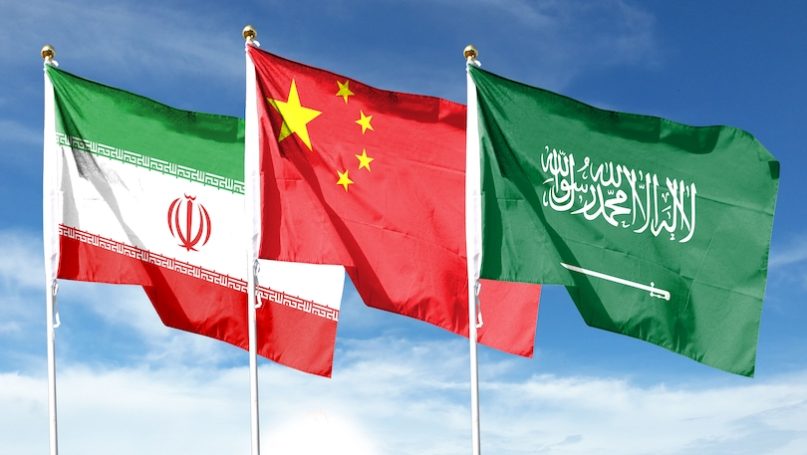
Aristotle famously said that nature abhors a vacuum suggesting that empty spaces tend to be filled by whatever is available. This assertion was soon refuted by his contemporaries like Epicurus and Lucretius; however, the idea may not be that irrelevant to contemporary global politics. The recent patch-up between Iran and Saudi Arabia, brokered by China, has taken observers of International Relations by surprise. There are two sides to the agreement that are particularly perplexing. First, why has the US left space open for political maneuvering in the region? Second, what are the underlying factors that propelled China to take up the role of the regional mediator?
The deal comes as a result of four days of undisclosed talks held in Beijing where the top security officials from both sides fine touched on the details. According to the statements issued, “both sides will respect the principles of sovereignty and the non-interference in internal affairs of the other country.” Moreover, both sides will “resume diplomatic relations between each other and re-open their embassies and missions within a period not exceeding two months.” This deal will bring much-needed respite to millions in West Asia that are devastated by sectarian violence caused by the Sunni camp headed by Saudi Arabia and a Shiite camp headed by Iran. Where the agreement has brought hope for peace, the images also told another story. Unlike the Oslo Accords or the Abraham Accords, the person in the middle was not a high ranking US official, but the Chinese minister for foreign relations. This is highly significant and brings back to the question of where China got the space to maneuver diplomacy and politics in the region.
Due to its shifting focus towards the Asia-pacific and subsequent strategic setbacks in the Middle East, the US has gradually lost its influence in the region and has created an empty space that China is now filling. In a speech to the Australian Parliament in 2011, US president Barack Obama announced a new foreign policy to rejuvenate its presence in Asia-Pacific while disengaging itself from the affairs of West Asia. US withdrawal from Afghanistan over a decade later, and the images of the Taliban returning to the streets of Kabul told the anti-climactic story of US influence in the region. Moreover, Bashar al-Assad’s ability to hold on to power in Syria, backed by Iran and Russia, was also not a comforting image for US allies. A humanitarian crisis in Yemen and American inability, or perhaps indifference, also signaled weakness and disregard for the region’s politics. All this led to a power vacuum that is now being filled by China.
The US’s attempt to counter China by disengaging from West Asian politics and moving towards the Asia-Pacific has come up with a great cost for the so-called global hegemon. Every American ally in the region is now pursuing strategic autonomy by balancing itself in a newly-developing geopolitical alignment. A reliance on the 2020 Abraham Accords to form a new regional security arrangement has failed because of US Gulf allies’ reluctance to work with the inflexible Netanyahu government in Israel. In an attempt to punish Pakistan for its misdeeds in Afghanistan and to bolster its partnership with India, the US has also further alienated its former strategic ally. Further, Turkey has defied the US by autonomously engaging with China, Russia, and Iran. Where all this draws a bleak picture for Washington, things have been better for Beijing.
By inking a deal between two regional powerhouses, China has significantly increased its political and diplomatic clout in the region. Where this deal might bring a sigh of relief in a region shattered by sectarian violence, it has also ensured China a foothold in both Sunni and Shiite camps of the Muslim world. Unlike the US, which distanced itself by withdrawing from the Iran-Nuclear Deal during the Trump administration, China has been active in nuclear negotiations with Iran and inking trade agreements. China’s active participation in the Shanghai Cooperation Organization has strengthened the organization, with China unofficially spearheading its reigns. The Belt and Road Initiative has also been a game changer for Chinese influence in the region, where it not only furthered its economic but also its political interests. Finally, diplomatic initiatives in Afghanistan, Syria, and Iran have signalled an active Chinese presence to all the countries in the region.
By pursuing agreements in the Middle East, China can build not only diplomatic bridges but also trade bridges. One of China’s biggest vulnerabilities is its energy needs, over 60% of which comes from imports. China’s dilemma is that in case of any conflict, the US can effectively cut off China due to its influence over international trade routes, especially in the Middle East. Hence, it is also worth considering the strategic implications of this deal for China. By ensuring stability in the region, China can focus on other objectives – for example, if the Strait of Hormuz is secured, China’s next focus will be the Strait of Malacca and the geopolitical hotspot of the South China Sea.
The pivot to the Asia-Pacific has caused tremendous damage to American leadership in West and South Asia. US inability, and sometimes nonchalance, to deal with the region’s affairs has resulted in a power vacuum. Standing up to the task, China has now started playing a more active role in the region. The Saudi-Iran deal might just be one episode of many more in the making.
Further Reading on E-International Relations
- Opinion – The Sino-Iran 25 Years Agreement: Why, and Why Now?
- Opinion – China and the US in Israel: The Lucrative Versus the Indispensable?
- Trump’s Foreign Policy Mantra: ‘Whoever Pays For It!’
- Opinion – Could the Sino-Iranian Agreement Weaken US Hegemony?
- Opinion – The Risks of China’s Growing Influence in the Middle East
- Opinion – US Export Controls and China’s Semiconductor Industry